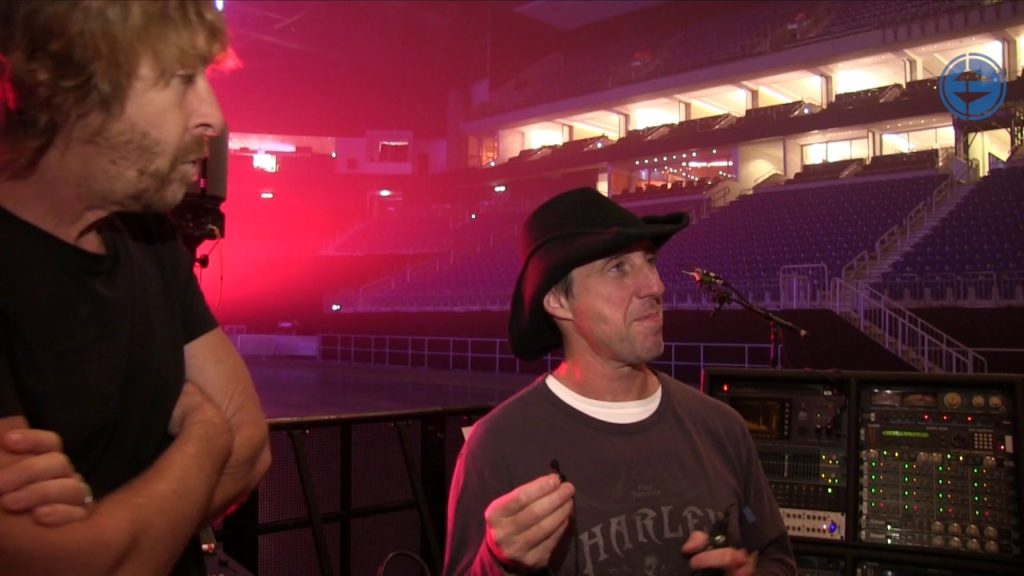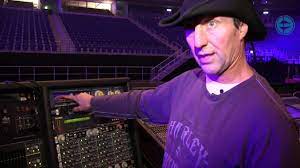In this video Dave Rat runs us through the Red Hot Chili Peppers (RHCP) FOH Live Sound Analog Mixing Setup from 2016
Dave goes in depth, explaining his RTA, microphone choice, FOH EQ, metering, effects, compression, compression, gates, channels and groups.

Video Text:
0:00:06. –>
all right how about a little tour of the um rack world here we’ve got um upon a house i’ve got my mic for the rta i run that about um head level if that was the um audience there trying to hear what i’m here i might move that around a bit i want to get a reference point that’ll show up in this rta there’s not a lot of stuff going on right now so not really hearing it now we can see something this is my main left right graph this is what i access during the show um to cut a frequency very quickly if i hear something i don’t like this is in series with it and this is kind of what i use to the cp10 i use to tune the system to sound the way i want if i’m touring with a rig or walking into a festival system this is what i’ll get most of this uh make the
0:01:01.2 –>
sound system sound like my headphones and this one here is kind of on the fly this is subwoofer eq left and subwoofer eq right i use these clark technique eqs because they’ve got five bands per channel and tysteria or 10 band mono and all bands are um 20 to 20k so i can use all five bands below 200 hertz this gives me a lot of control if i need it for the subwoofers i eq subs left and right so i have a little bit more so i don’t like to have mono substance here i’ve got something interesting this is the um duros test set you can go ahead and um pfl something here how about um a kick drum and we’ll put that here and this here is a sum and difference meter
0:02:00.1 –>
if i pan the kick drum down the middle you can see that i’m summing i’m gonna turn this down a little bit and you can see the sum is additive and the difference is not doing anything because it’s the exact same signal going to left and right but if i pan it the kick in and kick out to different sides now we can see that there’s a sum and a difference which means the two signals are not the same same thing happens if i bring one down i have a difference or if i bring that one back up so this is what i use to make sure that i’m not sending the same signal to left and right and like my guitar sound or whatever i’m doing because i try and avoid having the exact same sound come from more than one place pcm60 is the greatest reverb for me it’s very simple to get between presets and it’s a hard crunchy sound i also use this i overload the front end to get distortion effects that i need
0:03:01.5 –>
h3500 i’ve got stereo with flange i can punch things in very quickly here long digiplex auto panner phaser higher ground voice doublers recycle sexy vocorter micropitch shift so i can get around really quick and get all my effects these two effects do all of the effects for the um entire show uh chili peppers that is the fatso junior i’ve just started using this on vocals i’m pretty happy with it i usually use something that softens or warms i was using a drummer for a while 1960. i’ve got it pretty warm still messing with it but this is my vocal subgroups left and right this is my vocals guitar bass kick snare toms round things made out of metal
0:04:00.6 –>
i’m not sure what this is for this is keyboards and these are some individual compressors i believe this is on um individual baseline individual baseline josh’s vocal and keyboard i think i’m not sure i’m still sorting it out for this tour uh this is um anthony’s vocal channel and josh’s vocal channel and i use that to contain them a little more with the distressors this here is my left and right main pa to make sure that i’m sending these duros meters are great because they’re in 1db increments for every led so this makes sure i’m balanced left to right i just give me a really good indication what’s going on uh this is on the keyboard and this isn’t used yet still trying i may find a home for it now we’ll get into gates there’s a stereo gate kick inside kick out snare inside snare top and snare bottom
0:05:00.2 –>
rack 1 rack 2 rack 3 kettle drum snare 2 timbaly roto tom and octobon not necessarily in that order i haven’t memorized it all for this tour yet um here’s something that i do for the um whenever possible it’s an analog um crossover and it allows me to when i send the subwoofers to a festival system this allows me to manually low-pass their subwoofer system so if they’re running it at like 80 cycles or 100 cycles i don’t like the tone i can force it to cross over to lower frequency subwoofer left subwoofer right subwoofer limiter left subwoofer limit or right so i can compress the subs early if they’re too dynamic or i want to gain some more control and it comes out of these limiters into the sub feeds left and right for the festival or wherever i’m working or our system
0:06:00.3 –>
uh this london i’m not using yet this tour but this is a sub processor program that i’ve worked out that has some cool features i’ll maybe talk about some other time subharmonic synthesizer i use that as an effect to add some low end at the trailing ends of songs or just a tiny bit to add some more depth and to some of the slower mu some slower songs uh this is another left right eq and another left right subwoofer i’m sorry not left right left right main pa graph and secondary main replacing the cp-10 um sometimes i’ll do main left main right outer hang left outer hang right it’s to give me more control or i might run delay clusters or mono clusters so these are auxiliary eqs i’d like to have total control over the systems i’m working with this is all the a rig there’s a b rig on the other
0:07:01.9 –>
side behind me um here’s the console it’s still got um channel labels on it which will as soon as i memorize everything those will go away uh the band’s rehearsing right now as you can see all my channels come in pcm60 h3500 120. uh this is subwoofers for these super wedges here they have subs on an aux send and um this allows me to [Music] send to those vocal subgroups stereo guitar stereo bass stereo kick snare stereo toms stereo metal stuff stereo keyboards subwoofer send one subwoofer send two main pa and then my vca’s vocal guitar bass kick snare toms metal stuff everything all my channels pre-fader and all my channels post fader so i can if you watch my other video on mixing strategy you can see what i’m
0:08:01.2 –>
doing there and some other stuff synthesizer some effects piano my two effects returns um and some other instruments coming in all right so this is rehearsals and we’ll fire up more but that’s my setup cool
Other Engineers
FOH Engineer Garry Brown (Phish, Trey Anastasio Band, Oysterhead)
Behind the Live Sound of Coldplay with Daniel Green
Red Hot Chili Peppers – Dave Rat FOH Engineer
Toby Francis – Audio FOH Engineer – Red Hot Chili Peppers
Antony King – Front of House Engineer for Depeche Mode
Gavin Tempany – FOH Tame Impala, Mark Knopfler, Hans Zimmer, Kylie and Eskimo Joe
Analogue vs Digital, How to ‘Hear’ when Mixing with Andrew Scheps
